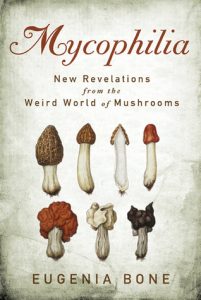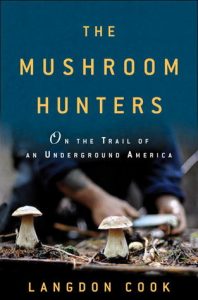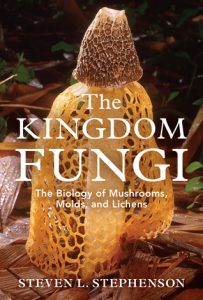 Fungi. Shrooms (magic and otherwise). Sporing bodies.
Fungi. Shrooms (magic and otherwise). Sporing bodies.
Yeah, I have to admit, that last one doesn’t have quite the right mouthfeel as a description of what you put into your mouth every time you eat a mushroom or other fungus, but either way, I am incredibly pro-mycophagy. A fungivore, if you will (though I eat more than just fungi, so perhaps that isn’t quite the most accurate description?), who will heartily agree that mushrooms “represent[ing] a distinct and unique food group that adds a great deal to a healthy diet… should be eaten enthusiastically” (Bone, Mycophilia, p.186). (So much so, in fact, that I actually misremembered this quote as saying mushrooms should be eaten with exuberance.)
I love gobbling up shiitake mushrooms in either side dishes or soups, and the thought of being able to try out a new mushroom strikes me as an exciting adventure*, to the point where the missed opportunity to do so not long ago actually haunts me a bit.** It was only recently that I started wanting to learn more about the mushrooms I love though, despite having grown up eating a variety of fungi & mushrooms: shiitake, cloud & wood ear fungi, and enoki, to name a few. My interest was piqued by my gardening ventures, for sure, but also the fact that there’s a fun book written entirely on the topic of mushrooms (I’m not sure if it qualifies as a microhistory exactly): Mycophilia by Eugenia Bone. Mycophilia is exactly what it sounds like: an ode to mushrooms that will have you digging up different organizations and festivals, and which will have you wanting to forage for more information about fungi, if not actually for the mushrooms themselves. (I should note though, that this is not a foraging guide, of which we also have a number: mushroom guides for Canada.)
Eugenia Bone is also the author of Microbia: A Journey Into the Unseen World Around You, which is written in just as approachable a manner for the lay person. I did find a few chunks in Microbia that were repeated from at least one chapter to another though, which jarred me a bit as I was reading through it because – didn’t I just read this?? – which might actually have been worsened by the fact that some facts are actually just repeated between the two books, but apart from that found it quite a fun and informative read. And in reading both Microbia and Mycophilia, I believe the main lesson that Bone comes away with is actually a bit larger than just their exact subjects: it is that this entire world is interconnected, and that there is no individual that can exist independently of what has been contributed by all the other organisms that have done their part to make the environment what it currently is.
With that in mind, check out some more books about fungi and mushrooms below!
*I should note that because I don’t have much knowledge about what mushrooms are safe to eat, I have yet to try wild foraging and wouldn’t trust myself to pick something edible from the ground without double- or triple-checking with someone more versed in the arts of fungi identification than me.
**On a recent trip to Kingston, I thought I had enough time to visit a mushroom farm and so passed up the opportunity to purchase some Lion’s Mane mushrooms from their stall at a farmer’s market, only to realize too late that I didn’t have enough time to go visit the farm. I went home mushroom-less. Alas.
 One of the chapters in Mycophilia talks about Bone’s experience with professional mushroom hunters, who follow the fungi where they sprout, and that’s exactly the subject of The Mushroom Hunters: On the Trail of an Underground America by Langdon Cook. The topic of mushroom hunters who follow the mushroom network is actually quite fascinating, both because you get to learn about a great variety of different types of wild mushrooms that get foraged – hunted – and also because Cook illustrates the sharp contrast between the bougie/hipster/trendiness of eating local and seasonally with the lot of the mushroom hunters, who for the most part exist on the outskirts of society. Some of the mushroom hunting takes place on private property or national parks – and might not actually be strictly speaking legal – the work is hard, the pay perhaps not that great, but for many mushroom hunters, it is a way to live off the land and it’s worth it in how rewarding it can be. Personally, I can only marvel at the mushroom hunters’ ability to tell one species from another, making sure what they are picking is the right one, or at least is not a poisonous lookalike!
One of the chapters in Mycophilia talks about Bone’s experience with professional mushroom hunters, who follow the fungi where they sprout, and that’s exactly the subject of The Mushroom Hunters: On the Trail of an Underground America by Langdon Cook. The topic of mushroom hunters who follow the mushroom network is actually quite fascinating, both because you get to learn about a great variety of different types of wild mushrooms that get foraged – hunted – and also because Cook illustrates the sharp contrast between the bougie/hipster/trendiness of eating local and seasonally with the lot of the mushroom hunters, who for the most part exist on the outskirts of society. Some of the mushroom hunting takes place on private property or national parks – and might not actually be strictly speaking legal – the work is hard, the pay perhaps not that great, but for many mushroom hunters, it is a way to live off the land and it’s worth it in how rewarding it can be. Personally, I can only marvel at the mushroom hunters’ ability to tell one species from another, making sure what they are picking is the right one, or at least is not a poisonous lookalike!
 If on the other hand you’d like to expand your knowledge of more than just mushrooms and extend it to include other fungi, including lichens and molds, The Kingdom Fungi: The Biology of Mushrooms, Molds, and Lichens by Steven L. Stephenson will be the perfect fit. The Kingdom Fungi explores the details of these fungi (along with “false” fungi such as slime molds), looking both at their structure & biology as well as their relationships with those who share their environment.
If on the other hand you’d like to expand your knowledge of more than just mushrooms and extend it to include other fungi, including lichens and molds, The Kingdom Fungi: The Biology of Mushrooms, Molds, and Lichens by Steven L. Stephenson will be the perfect fit. The Kingdom Fungi explores the details of these fungi (along with “false” fungi such as slime molds), looking both at their structure & biology as well as their relationships with those who share their environment.
A couple of other titles that might be of interest include: Teaming with Fungi by Jeff Lowenfels or Mushrooms and Their Cultivation by T. W. Sanders if you’d like to learn more about cultivating your own mushrooms.
And some more books for thought, that I’d love to read at some point in the future, that aren’t in our system: Beatrix Potter: A Life in Nature, because Beatrix Potter (author of Peter Rabbit, yes!) was an amateur mycologist who produced incredible illustrations of different mushrooms; Magical Mushrooms, Mischievous Molds by George W. Hudler, though I wonder if much of it would’ve been updated/covered in Mycophilia; and Chantarelle Dreams, Amanita Nightmares: The Love, Lore, and Mystique of Mushrooms by Greg Marley, as I’m pretty sure the mushroom lore is just as rich as their diverse realized forms.
And lastly, I’d just like to point out the Mycological Society of Toronto, which hosts forays as well as courses to educate the public and spread the love of mushrooms – mycophilia – far and wide.
I hadn’t bought mushrooms at the grocery store in a while but your post inspired me to revisit the shiitake and cremini piles in the produce section. I bought twice as much as I normally would have in mushrooms and made a stir-fry as soon as I got home. yum! Thanks for the inspiration. 😉
I also love when mushrooms crop up in my yard or when I see them in the park, but wouldn’t know if it was safe to eat them, although they look lovely. It would be neat to be expert enough to forage for them, quite a skill!
Me too! I get so excited when I see mushrooms on other people’s lawns or in my garden – I leave them alone since I don’t know if they’re edible, but yes, it would be so great to learn! I’m glad I inspired you to cook up a delicious mushroom stir-fry! 😀